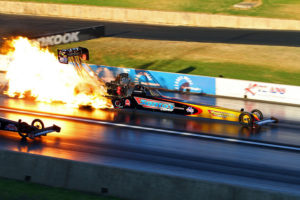Aim of the Challenge
- To drive from one end of the course to the other as fast as possible.
Control Method
- Autonomous
Time Limit
- 5 minutes
Rules

- The straight line speed course is a shallow trough of painted hardboard approximately 7.3m (24 feet) long with walls approximately 64mm high and set 534mm apart.
- There will be several ‘chicane’ sections where the course narrows slightly. Chicanes are only 38mm high.
- There will be a white line down the middle of the track to aid with navigation.
- The course will be driven three times and the times added together to make a final scoring time.
- The course will be laser-timed for accuracy. For more information on the laser-timing rig, take a look here.
- The competing robot must cross the finish line for the time to be recorded.
- The robot must be autonomous. A “start” and a “stop” button are permitted (whether on the robot or on the controller).
- You will need to manually retrieve your robot from the end of the course and return it to the start between runs.
Ranking and Points
- Competitors will be ranked according to the total amount of time taken to drive the course three times; the robot with the shortest combined time will take first place.
- Only those robots that have completed three runs will be eligible for ranking.
- Points will be awarded to the top ranked robots:
- 1st: 40 points
- 2nd: 32 points
- 3rd : 25 points
- 4th : 18 points
- 5th : 15 points
- 6th : 12 points
- 7th : 10 points
- 8th : 8 points
- 9th : 6 points
- 10th : 4 points
- 11th : 2 points
- 12th : 1 point
Additional Points
- 20 points will be awarded for each completed run.
- 20 additional points will be awarded for each run where the robot does not touch the sides of the course.
- 30 additional points will be awarded to the robot with the fastest individual run.
Penalties
- Each touch of the walls incurs a 10 second penalty up to a maximum of 30 seconds.
- Robots scraping along the wall(s) will be penalised to the maximum of 30 seconds.
- It is permitted to rescue the robot and place it back on the course at the place where things went wrong once per run without penalty, but the clock will not be stopped.
- An additional rescue is permitted, incurring a 15 second penalty.
- A third rescue is not permitted; instead the run must be abandoned.
- Abandoned or non-completed runs will be penalised by 60 seconds.
Hints
- A barrier will be placed at the end of the course (approx 50cm – 1m from the end of the course) to stop the robots, but it is to your benefit to work out some kind of ’shut off’ to avoid damaging your robot, or have someone at the end of the course to catch it.
- It is permitted to place a small ‘target’ for a robot’s camera to focus on at the end of the course, if desired.
- The white line should allow the use of line-following sensors or cameras to aid navigation.
- Previous robots have used the following techniques, amongst others, to remain ‘true’ on their runs:
- Encoders on the wheels to ensure that wheel power output is controlled individually.
- Sensors on the outside of the robot (e.g. ultrasonic sensors) to detect the walls and adjust the trajectory accordingly.
- Placing a coloured target at the end of the course for a camera to ‘lock’ onto.
Ask Questions and Discuss
You can discuss this challenge and ask questions on this discussion forum.
